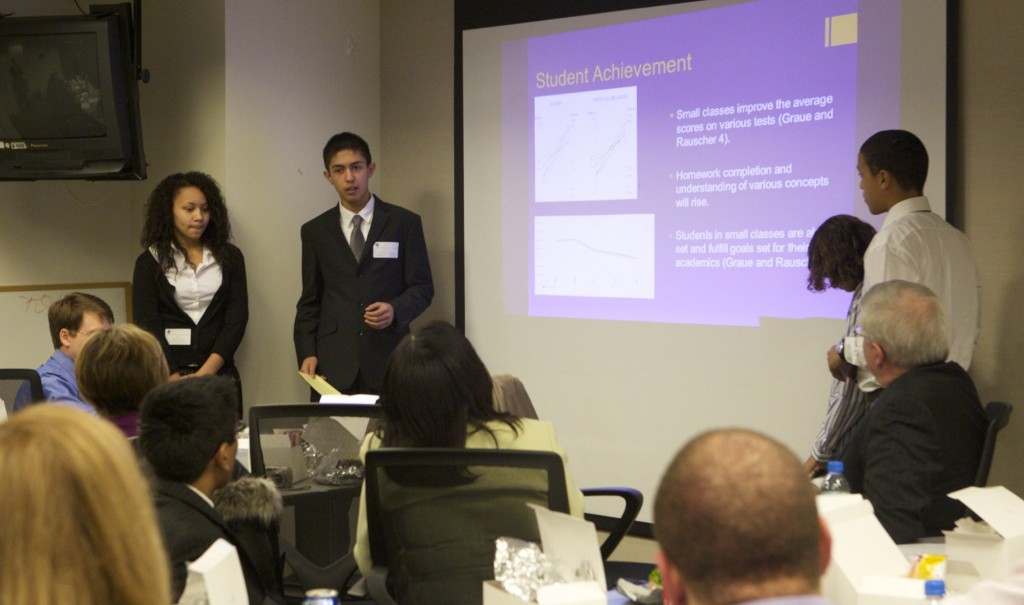Class size reduction. Standardized testing. Arts and music education. Increasing student engagement. Do these sound like issues the U.S. Department of Education is grappling with? You betcha, but so are 8th grade students from Roberto Clemente Middle School in Germantown, Maryland.
Last week 14 middle school students presented their research findings to ED staff on issues that affect their own learning. Their innovative ideas impressed everyone in the room and provided suggestions for fixing some of our country’s deepest problems. Rachit Argawal and Diwakar Ganesan shared, “Our current education model is conceived from the economic and social standpoint of the Industrial Revolution. Centuries later we have the same system!” They proposed creating a system where students in grades 6-12 choose the classes they take with math and English being the only compulsory subjects. They found that student choice increases motivation and achievement, counters distractions, and leads to autonomy and creativity.

Aries Tibbs, Luis Urzua, Noah Smith, and Kendall Pinales present the benefits of smaller class sizes to Department staff. Official Department of Education photo by Paul Wood.
Our 8th grade researchers were joined by national middle level experts that included Robert Balfanz and leaders from the National Forum to Accelerate Middle Grades Reform, the Association for Middle Level Education, and the National Association of Secondary School Principals. The national experts reminded us that young adolescents are complex, and in these crucial years, adolescents experience a great deal of physical, intellectual, emotional, and social change. Secretary Duncan described this period of youth as “a time of great contrasts—your students are immature but are becoming more mature every day. They are independent. Yet they still depend on adults.”
Educating middle level students requires a unique person who is demanding but caring. Rachit and Diwakar’s teacher Krista McKim is that kind of educator. She recognizes the unique abilities and experiences each student brings and facilitates learning that honors and includes student voice.
As an educator who has spent a decade teaching middle grades students I know that when young adolescents are seen as empty vessels waiting to be filled, they disengage. Conversely, when they are included in decision making and have opportunities to drive their learning, anything is possible. Motivation, interest, confidence, and creative thinking increase and true learning occurs. This was evident when the students presented their research. The group included a diversity of students: those with IEPs and 504 plans, some from the Gifted and Talented program, and a few students from the school magnet. We need all community members, including middle level students, tackling these complex issues.
Balfanz’s research shows that it is possible to identify about 75 percent of future dropouts in large, high-poverty urban schools before they enter high school. As early as 6th grade these students detach from school and reduce their effort and involvement in classes. Creating real opportunities for middle grades students to have a voice in their education is crucial.
Rachit and Diwakar concluded their presentation with a quote from Confucius: “If your plan is for one year, plant rice. If your plan is for ten years, plant trees. If your plan is for a hundred years, educate children.” What are you doing to ensure that our middle level students have a voice in their education?
Geneviève DeBose is a Washington Teaching Ambassador Fellow on loan from Bronx Charter School for the Arts in New York City.
Watch a video of students presenting their research findings at their school’s first Education Forum.






Middle schools students have been participating in visiting classrooms and providing feedback to teachers. Known as Data-in-a-Day, this is something that other schools might want to customize to their own contexts. For more information see
Ginsberg, M.B. (2001) “By the Numbers: Data-in-a-Day Technique Provides a Snapshot of Teaching That Motivates.” Journal of Staff Development, 22 (2), 44-47. Thanks,
I am a strong believer in allowing young people to not only express their voice but have adults genuinely listen. I was excited to see through this post that there are those of us out there who are committed to listening. What would the world look like if we let youth take the lead in their own education? Could we at least have them sitting at the table contributing to the decisions that impact their own future? I’m ready for that reality, are you?